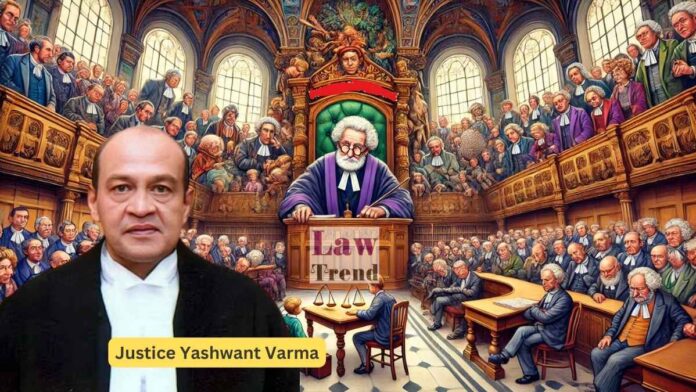On March 14, 2025, a fire broke out at the official residence of Justice Yashwant Varma, a sitting judge of the Delhi High Court, located at 30 Tughlak Crescent in New Delhi. While extinguishing the blaze in an outhouse storeroom, firefighters reportedly stumbled upon a significant amount of cash—allegedly partially burnt and stashed in jute sacks. The discovery, estimated by some reports to be around Rs. 15 crores, sparked widespread outrage and raised a pressing question: why was no First Information Report (FIR) immediately lodged against Justice Varma? The answer lies in a unique legal framework established by the Supreme Court of India that governs allegations of criminal misconduct against sitting judges, further clarified by Union Home Minister Amit Shah’s remarks at the Times Now Summit 2025.
The Incident and Its Aftermath
The fire occurred while Justice Varma was in Bhopal, and his family members alerted emergency services. After the blaze was doused, reports of cash recovery surfaced, prompting the Delhi Police to inform senior officials, who in turn notified the Chief Justice of India (CJI), Sanjiv Khanna. Videos and photographs allegedly showing burnt currency notes were shared with judicial authorities, leading to a swift response from the Supreme Court Collegium. Rather than an FIR, the CJI ordered an in-house inquiry, and Justice Varma was transferred back to his parent court, the Allahabad High Court, while being stripped of judicial duties pending investigation. Public speculation grew, with many questioning why standard criminal procedure—immediate FIR registration—was not followed.
Justice Varma, in his defense, has denied the allegations, asserting that no cash was recovered from his residence. He claimed the fire occurred in an unlocked outhouse accessible to staff and Central Public Works Department (CPWD) personnel, and suggested a conspiracy to tarnish his reputation. Despite his rebuttal, the absence of an FIR has fueled debates about judicial accountability and equality before the law.
What Does the Law Say?
The reason no FIR was lodged stems from a landmark Supreme Court judgment in K. Veeraswami v. Union of India (1991). This ruling established that sitting judges of the High Courts and Supreme Court cannot face criminal prosecution, including the registration of an FIR, without prior consultation with the CJI. The court held that judges are “public servants” under the Prevention of Corruption Act, 1988, and can be prosecuted for offenses like possessing disproportionate assets. However, to protect them from “frivolous prosecution and unnecessary harassment,” the process requires a safeguard: the CJI must assess the allegations and advise the President of India on whether an FIR should be permitted.
In the Veeraswami case, the court reasoned that this mechanism balances judicial independence with accountability. If the CJI deems the allegations credible, they can recommend prosecution; if not, no FIR can be filed. For a Chief Justice of the Supreme Court徐 slot online gacor Supreme Court Chief Justice, this precedent was further refined in subsequent rulings, such as Ravichandran Iyer v. Justice A.M. Bhattacharjee (1995), which formalized the “in-house procedure” for addressing complaints against judges short of impeachment.
Under this in-house mechanism, allegations are first investigated internally by a committee of judges—typically comprising a Supreme Court judge and two High Court Chief Justices—appointed by the CJI. Only if the inquiry finds prima facie evidence of criminality might the CJI recommend further action, including an FIR or impeachment proceedings under Article 124(4) of the Constitution. Until then, law enforcement agencies like the police cannot act independently.
Application to Justice Varma’s Case
In Justice Varma’s case, the process unfolded as per this framework. Following the cash recovery reports, CJI Sanjiv Khanna constituted a three-member committee—comprising Justices Sheel Nagu, G.S. Sandhawalia, and Anu Sivaram—to probe the incident. The Delhi High Court Chief Justice, D.K. Upadhyaya, submitted a preliminary report, and the Supreme Court made these documents public to ensure transparency. The committee’s findings will determine the next steps, which could range from clearing Justice Varma to recommending criminal action or impeachment.
On March 28, 2025, Union Home Minister Amit Shah addressed the issue at the Times Now Summit 2025, marking the government’s first public response to the controversy. He emphasized the legal constraints, stating, “No FIR can be registered without the CJI’s permission. When no FIR can be registered, how can a seizure be carried out? A panel of judges is looking into the matter, and we should wait for its report.” Shah further clarified that the Delhi Police and fire brigade are cooperating fully, providing all requested documents to the inquiry committee, and urged patience until the findings are made public.
Criticism and Debate
The Veeraswami ruling and the in-house procedure have long been contentious. Critics argue that requiring CJI approval creates a privileged class, shielding judges from the swift accountability ordinary citizens face. In Justice Varma’s case, petitioners like Advocate Mathews J. Nedumpara contended that the delay in FIR registration risked evidence tampering and eroded public trust, especially given the gravity of the allegations. They challenged the 1991 judgment as violating the constitutional principle of “equality before law,” asserting that police should have acted immediately upon discovering unaccounted cash.
Defenders of the system, however, stress that judges’ independence is vital to democracy, and premature FIRs could be weaponized to intimidate or discredit them. The in-house process, they argue, ensures a fair assessment before exposing judges to public prosecution.
What Happens Next?
As of March 29, 2025, Justice Varma’s fate hinges on the in-house committee’s report. If it finds no wrongdoing, he could resume judicial duties, potentially at the Allahabad High Court following his transfer. If evidence of misconduct emerges, the CJI could greenlight an FIR or escalate the matter to Parliament for impeachment—a rare and cumbersome process requiring a two-thirds majority in both Houses.
The controversy has reignited calls to revisit the Veeraswami precedent and reform judicial accountability mechanisms. For now, the law—and Home Minister Shah’s stance—dictates patience: no FIR can be lodged against Justice Varma until the internal process concludes. Whether this upholds justice or shields privilege remains a matter of fierce debate, underscoring the delicate balance between judicial integrity and public trust.




